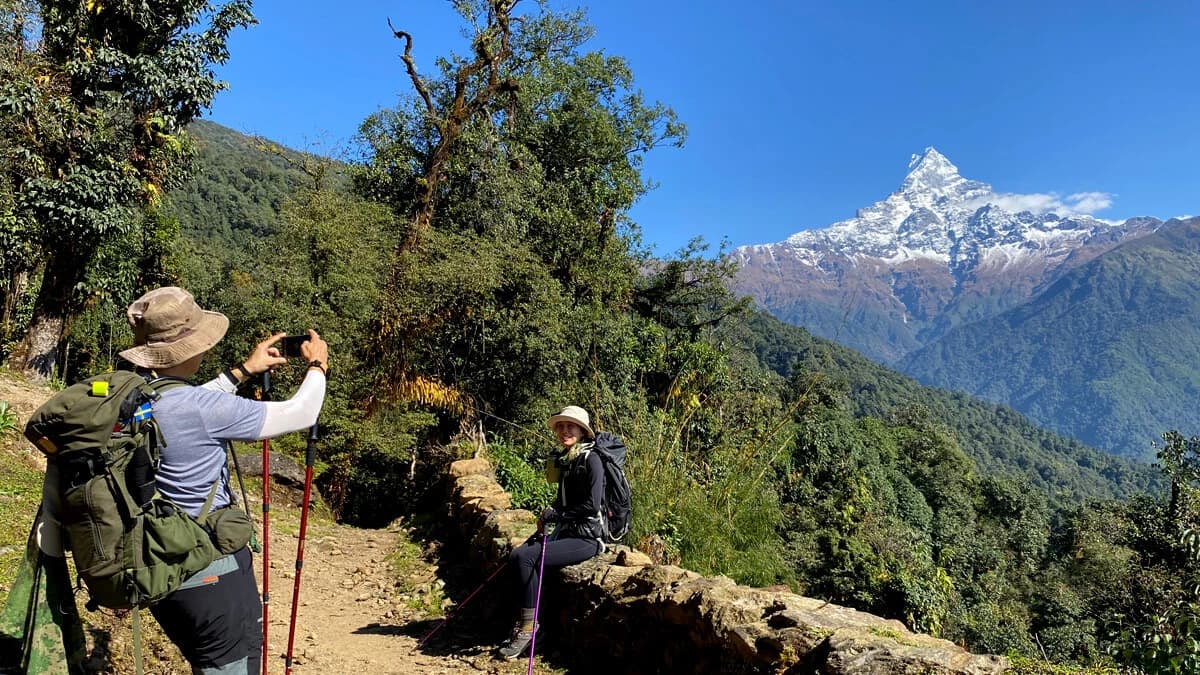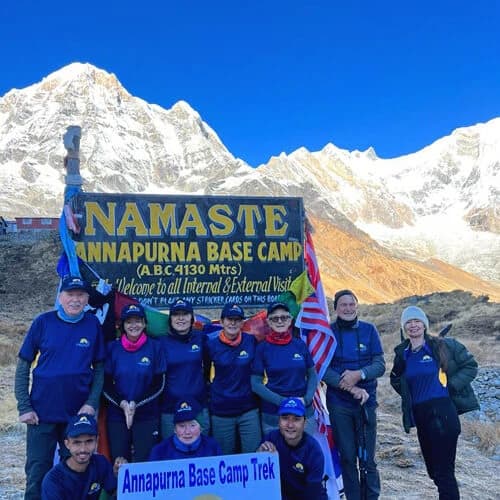"The Annapurna Base Camp Trek is a memorable journey to the majestic Annapurna Massif. Despite its massive appeal among trekkers, questions arise regarding the safety concerns among beginners. So, Is ABC Trek Safe? Yes, trekking to the Annapurna Base Camp is safe, but you must understand and prepare for factors that make the journey challenging."
Is Annapurna Base Camp Trekking Safe?
Trekking to the Annapurna Base Camp is Safe
The Annapurna Base Camp (ABC) is considered to be safe when done with a qualified guide and ensuring proper precautions and preparations. The trek trail is well-maintained, with several teahouses, lodges, and infrastructures along the way. However, like any high-altitude trek, it has inherent several risk factors, which must be considered.
Annapurna Base Camp (ABC) is one of Nepal's most iconic and well-known trekking routes, covered by tourists from across the globe. Trekking to the Annapurna Base Camp takes you beyond the altitude of 4,000 meters (13,123 feet). While it might not sound challenging, people from lower altitudes, like sea level, might be at risk of Acute Mountain Sickness.
Situated in the heart of the Annapurna region, this trek is a stunning walk through diverse landscapes, from subtropical forest and terraced landscapes to alpine meadows and glacial terrain. It leads to the base camp of Annapurna I, the 10th-highest peak in the world. Renowned for its well-trodden trails and breathtaking scenery, the ABC trek takes 7 to 12 days, depending on the route and pace.
Is Annapurna Base Camp Trek Suitable for Beginners?
The Journey to Annapurna Base Camp is an ideal option for beginners due to its well-marked routes, moderate degree of difficulty, and easy accessibility of infrastructure. With planning, guidance, and preparation, beginners can easily turn the journey into a safe and memorable experience. Additionally, the route offers gradual altitude gain and teahouses at important spots for rest, which is crucial for acclimatization.
- The trail is well-marked, reducing the danger of getting lost.
- Regular tea house stopovers along the trail provide food, and shelter.
- The ascent is gradual, allowing time for acclimatization and reducing the danger of altitude sickness.
- Experienced local guides and porters who can offer support and safety will be provided.
- Helicopter evacuation is available if needed in case of an emergency.
- The best time to trek (autumn and spring) ensures reliable weather and safer trail conditions.
- The path is full of trekkers, so help is generally available from fellow hikers or locals.
Challenges During the ABC Trek
While the ABC trek offers travelers a once-in-a-lifetime opportunity to experience nature's breathtaking grandeur, it is equally challenging. To have an enjoyable and safe travel, every trekker must know the factors contributing to the trek's difficulty level.
Gradual Elevation/Altitude Gain
The Annapurna Base Camp (ABC) involves a maximum elevation of 4,130 meters (13,550 feet), which is moderate height, especially for first-year students new to high-altitude trails. Previous high-altitude experience is not required, but basic fitness and preparation guarantee a safe and enjoyable experience. While Acute Mountain Sickness (AMS) is always possible, the trek is not risky, but coordinated with a gradual climb and a beaten trail. Compared to high-altitude treks like Everest Base Camp, ABC is a gentle ascent, giving time for acclimatization.
Generally, a trek itinerary to ABC ranges from 7 to 12 days, providing sufficient time to rest and acclimatize. For beginners, it's essential to keep the pace slow and steady, hydrate well, eat healthy food, and monitor early signs of AMS such as headache, nausea, or dizziness. Also, comfortable tea houses and lodgings on the trail allow travelers to rest and adapt to the elevation. With proper planning and acclimatization, the Annapurna Base Camp trek remains a safe and satisfying first-time experience for Himalayan trekking.
Weather Patterns and Their Impact on Trekking Safety
Weather conditions significantly impact the safety and overall quality of the Annapurna Base Camp, with significant seasonal variations impacting trail conditions. The best trekking times are the pre-monsoon (March, April, May) and post-monsoon (September, October, November) seasons. During this time of the year, the weather is more settled, skies are clear, and temperatures range from 10°C to 20°C (50°F-68°F) at lower elevations and dip to -5°C to 5°C (23°F-41°F) at the base camp. These seasons offer the best visibility and clearer paths, minimizing the threat of landslides or avalanches.
Alternatively, trekking during monsoon (June, July, August) is risky due to heavy rain, slippery trails, leeches, and regular landslides. Visibility is bad, and it is hotter, but the trail conditions become significantly worse. Winter (December, January, February) offers frigid temperatures that drop below -10°C (14°F) at higher altitudes, with heavy snowfall that may block trails and leave one vulnerable to avalanches or hypothermia. So, knowledge and understanding of seasonal weather patterns are required for safety. The trekkers must plan, carry the appropriate equipment, and remain flexible with their schedule to acclimate to changing conditions for a safe trekking adventure.
Trail Conditions: Navigating the Annapurna Base Camp Path
Annapurna Base Camp trek features diverse terrain, ranging from stone-paved roads and terraced fields to forest paths, suspension bridges, and rough mountain tracks. Treks become steeper and narrower as the travelers ascend higher, with uneven rock and sometimes slippery or icy surfaces at higher altitudes. Moreover, the risk of landslides and muddy trails causes additional hazards during monsoons and winter. It is recommended to be cautious and maintain careful footing to avoid slipping and injuring yourself.
Regardless, the path is often easy to dry and to follow using well-positioned signs and regularly marked trails. But unpredictable weather might bring in fog and rain, which reduces visibility. So, travelers must have a guide to navigate the trail safely. Additionally, we suggest you hike gradually, drink plenty of water, and avoid trekking in the early morning or late evening. Besides, observing your surroundings and inquiring about trail conditions before hiking all help make the trip safer and more enjoyable for Annapurna Base Camp.
Physical Challenges During the ABC Trek
Annapurna Base Camp Trekking has significant physical requirements, which beginner trekkers must be prepared for. Trekkers typically trek 5–7 hours daily over steep climbs and descents, which is exhausting. It could be immensely challenging for those not accustomed to consistent physical work. Trails vary, from steep stone staircases to uneven rocky trails, and require balance and stability. The weather's unpredictability makes the trek even more challenging. Sudden rain, snow, or temperature changes can result in slippery and treacherous roads.
On the other hand, although the trek's highest point is 4,130 meters, trekkers are at risk of altitude sickness or Acute Mountain Sickness. The early signs of altitude sickness include headaches, nausea, and insomnia. You can tell your guide about these symptoms, and you will receive immediate medical attention. If the symptoms persist, we will transfer you to the nearest health facilities for further treatment. Overall, the challenges of the trek might sound daunting. However, you can overcome the obstacles through proper preparation and training, making the Annapurna Base Camp trek a challenging but possible journey.
Physical Fitness Requirements for Safe Trekking
While the Annapurna Base Camp is not immensely difficult, it still requires good physical fitness. You must push your body to the limits and walk on steep rocky terrains at high elevations. It becomes crucial for participants to condition their bodies beforehand because it reduces fatigue and exhaustion and avoids injuries. A well-planned training schedule is required a few weeks before the trek to make it a trouble-free and enjoyable experience. We recommend you begin a workout regimen 3 to 4 months before the trip date. Some of the exercises you can include in your daily routine must consist of:
- Hiking, jogging, cycling, or swimming 3–5 times a week for stamina.
- Exercise leg muscles with squats, lunges, step-ups, and core and back exercises for muscle endurance.
- Replicate trekking conditions by brisk walking or jogging with a weighted backpack.
- Practicing yoga or stretching exercises avoids injury to muscles and improves balance.
Note: Consult a doctor if you have underlying medical conditions.
Health Precautions: Preventing Altitude Sickness
Anyone trekking at 2,500 meters and higher, including the Annapurna Base Camp, is likely to experience altitude sickness. Early detection of symptoms and prevention are crucial for your well-being and a safe trek experience. If you experience any signs, you must report to our guide for immediate medical attention. We also recommend the following guidelines to prevent any illness complications and alleviate them effectively.
- Common symptoms are headache, dizziness, nausea, fatigue, loss of appetite, and insomnia, so look out for those.
- Do not ascend more than 300–500 meters of altitude gain per day after reaching 2,500 meters in altitude.
- Take rest days to enable your body to acclimatize in higher altitudes more efficiently.
- Drink 3–4 liters of water daily and avoid alcohol and caffeine.
- Maintain energy through a balanced, high-carbohydrate diet.
- Trek slowly and consistently and listen to your body for any warning signs.
- Consult a doctor regarding taking acetazolamide (Diamox) to avoid AMS.
- Never ignore the symptoms, and descend immediately if your conditions worsen.
Emergency Services and Rescue Operations in the Region
Rescue services and emergency services in the Annapurna Base Camp region are far improved now compared to what they have been over the years. The area has medical centers in larger villages like Chhomrong and Ghandruk, where trekkers are treated for illnesses and injuries. Helicopter rescues are arranged swiftly in case of severe illness or injury and are the region's most efficient form of rescue.
An emergency air evacuation will transport individuals to hospitals in Kathmandu or Pokhara within hours for treatment. Please keep in mind that the helicopter rescues are costly, so it's essential to have travel insurance that covers medical bills and high-altitude air evacuation. Overall, with proper preparation and backup, emergency services in the Annapurna region are effectively arranged, as they are an important part of the safety protocols.
Choosing the Right Trekking Season: Safety Implications
It is essential to select the right season to ensure a safe and enjoyable Annapurna Base Camp. As seasonal variation significantly affects weather, visibility, trail conditions, and safety, it becomes crucial to trek at the right time to minimize the risks involved. These include weather hazards and natural disasters like landslides, snow blockage, and poor visibility. So, understanding the characteristics of every season allows trekkers to prepare and avoid unpredictable weather events.
Autumn (September, October, November):
- It offers clear skies, lush mountain scenery, a stable climate, dry and well-trodden paths, and a minimal chance of snowfall or landslide.
- Day temperatures range from 10°C to 20°C (50°F and 68°F).
Spring (March, April, May):
- The region blooms with colorful rhododendron flowers, pleasant temperatures, and good trail conditions for trekking.
- Day temperatures between 12°C to 22°C (54°F to 72°F).
Note: Avoid the monsoon (June, July, August) and winter (December, January, February) because of heavy rains, wet trails, landslides, leeches, travel disruptions, poor visibility, snowy trails, and avalanches.
Hiring Guides and Porters: Enhancing Trekking Safety
Hiring local guides and porters for the Annapurna Base Camp offers security and cultural benefits, especially for novice travelers. Guides are trained in first aid, familiar with the landscape, and skilled in dealing with altitude issues. They can spot signs of altitude sickness and act accordingly, which is crucial in remote mountain landscapes. They also offer the advantage of navigation expertise, keeping you on the right trail and away from potential danger. On the other hand, Porters relieve the physical burden by carrying heavy backpacks, minimizing the risk of fatigue or injury. This allows trekkers to conserve energy, maintain a steady pace, and travel more comfortably.
What is Annapurna Base Camp?
Annapurna Base Camp (ABC) is a popular trekking destination in Nepal situated at an altitude of 4,130 meters (13,550 feet). It lies at the foot of the Annapurna Massif, and from the location, one obtains spectacular views of Annapurna I, Machapuchare (Fishtail), and other surrounding mountains.
Where is Annapurna Base Camp located?
Annapurna Base Camp is located in the Annapurna Conservation Area of mid-western Nepal, in the Gandaki province.
Is it safe to trek without a guide or porter?
Yes, experienced trekkers can trek without a guide or porter. However, hiring a guide or porter is highly recommended for added security, local knowledge, and support with altitude and exhaustion.
When is the safest time to trek to Annapurna Base Camp?
The safest and best times to trek are during the pre-monsoon (March to May) and post-monsoon (September to November). During these months, the weather is stable, visibility is good, and trail conditions are better.
Is travel insurance necessary for the ABC trek?
Yes, travel insurance is highly advisable. It should include medical bills, evacuation (including helicopter rescue), flight delay/cancellation, loss, theft, and trip cancellations.
How are the trail conditions on the Annapurna Base Camp trek?
The trail conditions in the peak trekking season of autumn and spring are dry, accessible, and not covered in layers of ice and snow. On the other hand, the route gets muddy and inaccessible in some sections during monsoon and winter.
Some Most Popular Treks
- Everest Base Camp Trek - 14 Days
- 12 Days Everest Base Camp Trek
- Everest Base Camp Luxury - 14 Days
- Everest Cho La Pass - 17 Days
- Everest High Pass 16 - Days
- Annapurna Base Camp - 13 Days
- Ghorepani Poon Hill - 7 Days
- Annapurna Circuit - 17 Days
- 12 Days Annapurna Circuit Trek
- Manaslu Circuit - 14 Days
- Manaslu Trek 12 Days
- Everest Base Camp with Island Peak - 16 Days
- Everest Luxury Trek with Helicopter Return
- Langtang Valley - 10 Days




